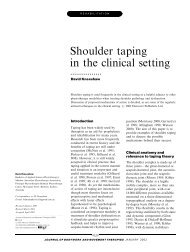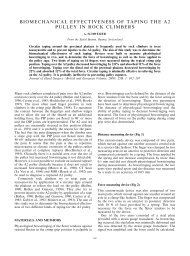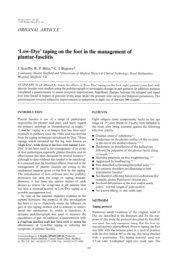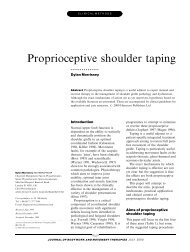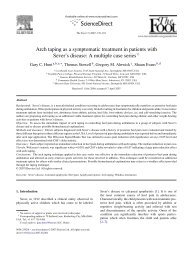The Effect of McConnell's Vastus Lateralis Inhibition Taping ...
The Effect of McConnell's Vastus Lateralis Inhibition Taping ...
The Effect of McConnell's Vastus Lateralis Inhibition Taping ...
You also want an ePaper? Increase the reach of your titles
YUMPU automatically turns print PDFs into web optimized ePapers that Google loves.
<strong>The</strong> <strong>Effect</strong> <strong>of</strong> <strong>McConnell's</strong><strong>Vastus</strong> <strong>Lateralis</strong> <strong>Inhibition</strong><strong>Taping</strong> Technique on <strong>Vastus</strong><strong>Lateralis</strong> and <strong>Vastus</strong> MedialisObliquus ActivityKey Words173Patell<strong>of</strong>emoral pain syndrome,VL:VMO activity,quadriceps imbalance,EMG, McConnell taping.by Sue TobinGill RobinsonSummary This study was conducted to investigate the effects <strong>of</strong>Jenny McConnell’s vastus lateralis (VL) inhibition taping techniqueon VL and vastus medialis obliquus (VMO) muscle activity, and itspossible application in quadriceps rehabilitation, particularly inpatell<strong>of</strong>emoral pain syndrome.Eighteen asymptomatic subjects (11 female and 7 male)participated, and completed a functional task (stair descent) underthree test conditions: no tape, placebo tape and active tape.Surface electrodes were used to determine theelectromyographic activity <strong>of</strong> VL and VMO during the tests.High variance and abnormal distribution meant that the datarequired non-parametric analysis, which was completed withFriedman and Wilcoxon tests for each muscle. Results <strong>of</strong> theFriedman test for VL revealed a significant difference in activityacross the conditions (p < 0.05). Further investigation with theWilcoxon tests revealed that the application <strong>of</strong> the active tape wasresponsible for significantly decreasing VL activity. <strong>The</strong> Friedmantest on VMO activity revealed no significant difference betweenexperimental conditions (p > 0.05), although a Wilcoxon testbetween the placebo tape and active tape conditions wassignificant.<strong>The</strong>se findings suggest that McConnell’s VL inhibition tapingtechnique does inhibit VL, but the effects <strong>of</strong> this inhibition onVMO require further investigation.Tobin, S and Robinson, G(2000). ‘<strong>The</strong> effect <strong>of</strong>McConnell’s vastuslateralis inhibition tapingtechnique on vastuslateralis and vastusmedialis obliquusactivity’, Physiotherapy, 86,4, 173-183.IntroductionPatell<strong>of</strong>emoral pain syndrome (PFPS) is thesecond most common musculoskeletalcomplaint presented to physiotherapists(Witvrouw et al, 1996; Hilyard, 1990).Clinical features <strong>of</strong> PFPS include theinsidious onset <strong>of</strong> diffuse retropatellar pain,aggravated by squatting, kneeling, stairs,slopes, prolonged flexed knee sitting, andrising after prolonged sitting (Arroll et al,1997; Hilyard, 1990). Many factors areinvolved in complex interactions thatinfluence the patell<strong>of</strong>emoral joint, and theexact aetiology <strong>of</strong> PFPS is <strong>of</strong>ten enigmatic(Fulkerson and Hungerford, 1990;Finestone et al, 1993). However, there isconsensus that malalignment andmaltracking <strong>of</strong> the patella are major features<strong>of</strong> PFPS (Maclntyre and Robertson, 1992;Gerrard, 1989). While accepting that manyfactors and structures influence PFPS, thisstudy focuses on the role <strong>of</strong> the quadricepsfemoris muscle group, with particularemphasis on vastus lateralis (VL) and vastusmedialis obliquus (VMO).<strong>The</strong> force generated by and withinthe quadriceps is recognised as a majorinfluence on patellar tracking (Roberts,1989; Knight, 1985), and interplay withinthis group is vital to efficient functioning <strong>of</strong>the patell<strong>of</strong>emoral joint (Herrington andPayton, 1997; Witvrouw et al, 1996).Disruption <strong>of</strong> the tension characteristics<strong>of</strong> component quadriceps can induceimbalance in the transverse forces acting onthe patella (Karst and Jewett, 1993). Relativeweakness in one <strong>of</strong> the quadriceps willdisrupt the normal synergy <strong>of</strong> the groupand induce imbalance. Although thereis disagreement whether quadricepsdysfunction is a primary or secondaryoccurrence in PFPS, it is accepted as aninherent part <strong>of</strong> the vicious cycle that isfrequently identified. A model for thepathogenesis <strong>of</strong> PFPS is presented in figure 1overleaf.<strong>The</strong>re is a well-established link betweenVMO insufficiency and PFPS (Kowall et al,1996; McConnell, 1987b). Boucher et al(1992) found that increased severity <strong>of</strong> PFPSsymptoms correlated with decreasing VMOactivity. Ahmed et al (1988) found that a50% reduction in VMO activity produced a5 mm lateral shift <strong>of</strong> the patella, whichrepresents a considerable disruption topatellar tracking.Traditionally, the cornerstone <strong>of</strong>physiotherapeutic intervention in PFPS hasinvolved general quadriceps strengthening(Antich and Brewster, 1986; Karst andJewett, 1993), with many protocols beinghighlighted in literature from more than 50years ago (Nicoll, 1943; DeLorme, 1945).That they are still used today, despite laterPhysiotherapy April 2000/vol 86/no 4
174VMO functionQuadriceps imbalance<strong>Inhibition</strong> <strong>of</strong> musclefunctionDynamic patellarstabilisationOverpull by VLPainEffusionLateral displacement <strong>of</strong>patellaJoint damageArticular cartilagestressFig 1: Pathogenesis <strong>of</strong> patell<strong>of</strong>emoral pain syndrome (adapted from Stokes and Young (1994), Richardson (1985) and Pevsner et al (1979)advances in biomechanics, pathophysiologyand knowledge <strong>of</strong> specificity <strong>of</strong> musclefunction, gives cause for concern. AsRichardson wrote in 1985: ‘For too long, allmuscles have been exercised on the sameprinciples without accounting for thedifferent muscle types and their behaviourpatterns.’<strong>The</strong> use <strong>of</strong> quadriceps programmes thatdo not address muscle specificity and thecrucial interplay between the components <strong>of</strong>this muscle group may help to explain whymany treatment protocols have the poorlong-term success rates identified byDevereaux and Lachman (1984) andFitzgerald and McClure (1995), and whyPFPS frequently becomes a chronic disorder.<strong>The</strong> onus is on physiotherapists to establishmechanisms to isolate or disproportionatelystimulate the activity <strong>of</strong> one muscle withrespect to the others, ie to manipulate thecomponents <strong>of</strong> a muscle group to restoreoptimal synergy. That VMO and VL havedifferent specificity <strong>of</strong> function ishighlighted by their respective physiologicalfeatures, which are presented in table 1.Table 1: Physiological features <strong>of</strong> VL and VMOFeature VL VMO ReferenceMuscle type Mobility Stability Richardson (1985)Muscle fibre 15° to 18° to 46° to 52° to Lieb and Perry (1968)alignment femoral axis femoral axisMuscle fibre Predominantly Predominantly type I Herrington and Payton (1997)type type II fast twitch slow twitchMuscle activity Phasic power Tonic, endurance McConnell (1995)Action Leg extension Dynamic patellar Speakman andstabilisation Weisberg (1977)Active range Throughout knee Throughout knee Speakman andflexion/extension flexion/extension Weisberg (1977)Functional Maximal when Maximal in work Richardson (1985)activity distal segment associated withis freejoint compression,eg weightbearingInterrelationship Agonist Antagonist Hodges andRichardson (1993)Adaptive To become short To become long Norris (1996)tendencies and tight and weakPhysiotherapy April 2000/vol 86/no 4
Pr<strong>of</strong>essional articles175<strong>The</strong> advent <strong>of</strong> the McConnell patell<strong>of</strong>emoraltreatment plan (1985) provideda development in physiotherapeuticintervention in PFPS. McConnell’s planworks on the premise that if a patient’ssymptoms are due to poor patellaralignment, then correcting this alignmentshould reduce the symptoms, allowingthe undertaking <strong>of</strong> a functional rehabilitationprogramme designed to stimulateVMO activity preferentially, therebyaddressing the accompanying quadricepsimbalance. By using tape toaddress patellar position, the VMO isassisted in its efforts to resist the pull <strong>of</strong> theVL and stabilise the patella (McConnell,1995). Facilitating the VMO away from alengthened position also optimises itspotential for cross-bridge formation (Harms-Ringdahl, 1993), and allows it to work froma position <strong>of</strong> increasing mechanicaladvantage, which should facilitate theincreased muscle activity required forhypertrophy.Research findings into McConnell’spatellar taping techniques are numerousand somewhat contradictory (Brockrath etal, 1993; Cerny, 1995; Crome et al, 1987;Gerrard, 1989; Shelton, 1992). However, allthese studies, as well as McConnell’s ownwork, have focused on directly increasingVMO activity to establish optimal VMO:VLbalance. None has addressed the possibility<strong>of</strong> restoring this balance through thereduction <strong>of</strong> VL activity. Although Witvrouwet al (1996) briefly refer to retarding VLactivity, and McConnell herself has devised ataping technique designed to do this,literature searches revealed no studies inthis area.McConnell proposes in her course handbookthat her VL inhibition technique worksvia the type IV nociceptors, but does notelaborate. Given the dearth <strong>of</strong> relevantliterature, it is appropriate to proposemechanisms by which application <strong>of</strong> thistechnique could inhibit VL activity, and als<strong>of</strong>acilitate VMO activity.Type IV nociceptors respond to deepmechanical stimuli, and have small diameterC-fibre afferents which bifurcate uponentering lamina I and lamina II (substantiagelatinosa) <strong>of</strong> the dorsal horn in the spinalcord (Kandel et al, 1991, page 386).It is therefore conceivable that, via thelocal inhibitory interneurones, alpha motorneurones <strong>of</strong> VL are inhibited by thestimulation <strong>of</strong> nociceptors. This wouldreduce the electrical activity withinVL, which should be detectable byelectromyography (EMG). Whether thehigher centres, stimulated by projectionneurones, would exert any influence isunclear.For the proposed influence on VMOmuscle activity there are at least two possiblemechanisms. <strong>The</strong> first is biomechanical/physiological and involves the previouslymentioned facilitation <strong>of</strong> VMO into aposition <strong>of</strong> increasing mechanical advantageand cross-bridge formation. This mechanismrequires adaptive shortening and would takeseveral days for any effect to becomeapparent. <strong>The</strong> second possibility isneurological and counters the VLmechanism. Nociceptive afferents fromVL could influence local excitatoryinterneurones supplying the alpha motorneurones <strong>of</strong> the antagonist muscle, ie VMO.Similar types <strong>of</strong> neural circuits are alreadyestablished, eg the flexor withdrawal reflex(Kandel et al, 1991, page 588). If this neuralcircuit were used, the electrical activity inVMO would increase which should bedetectable by EMG.DesignEighteen asymptomatic volunteers took partin a same subject test-retest study, therebyensuring optimal group matching (Robson,1996, page 94). Counterbalancing was usedto overcome inherent dangers <strong>of</strong> order,fatigue and carry-over effects (Hicks, 1995,page 72).<strong>The</strong> activity chosen for analysis was stairdescent, partly for its functional relevanceto daily activities, and partly because it formspart <strong>of</strong> McConnell’s VMO trainingprogramme (McConnell, 1995).<strong>The</strong> experiment involved three testconditions: no tape (control); placebo tape;and active tape.Each subject was tested three times undereach <strong>of</strong> the experimental conditions, withEMG being used as an appropriate measure<strong>of</strong> muscle activity (Kumar and Mital, 1996).Apparatus and MaterialsFixomull ® stretch tapeLeukotape ® P tapeEMG with MIE MT8-MBM base unit andtelemetry belt2 x 4 k pre-amplifiersSelf-adhesive silver-silver chloride electrodesMyodat 5.0 s<strong>of</strong>tware packageSPSS s<strong>of</strong>tware packageAuthorsSue Tobin BHSc MCSP isa physiotherapist at theRoyal LiverpoolUniversity Hospital. Thisis an abridged version <strong>of</strong>her dissertation, whichwas submitted in parialfulfilment <strong>of</strong> the BHScphysiotherapy course atthe University <strong>of</strong> Leeds.Gill Robinson MCSPDipTP is a seniorlecturer, Division <strong>of</strong>Physiotherapy, School <strong>of</strong>Human and HealthSciences, University <strong>of</strong>Huddersfield HD1 3DH.She was the projectsupervisor.This article was receivedon February 22, 1999,and accepted onDecember 2, 1999.Address forCorrespondenceMiss S Tobin BHSc MCSP.PhysiotherapyDepartment, RoyalLiverpool UniversityHospital. Prescot Street,Liverpool L7 8XP.Physiotherapy April 2000/vol 86/no 4
176placed 2 cm from the superomedial border<strong>of</strong> the patella. Correct electrode position wasconfirmed by palpation during quadricepscontraction with and without hip adductionto distinguish between the VMO and thevastus medialis longus (Bose et al, 1980).Ground electrodes for both muscles wereplaced over convenient, electricallyindependent bony landmarks (Worrell et al,1995). For the VL, the head <strong>of</strong> fibula wasdeemed appropriate, and for the VMO it wasthe anterior tibial shaft.Fig 2: Tape standardisation linesFig 3: Application <strong>of</strong> three pieces <strong>of</strong> Fixomull ®ProcedureAreas required for electrode placement wereshaved, lightly abraded with sandpaper andcleaned with acetone to reduce impedance(Kumar and Mital, 1996).Active electrodes for VL and VMO wereplaced parallel to each other with an interelectrodedistance <strong>of</strong> 1 cm (Herrington andPayton, 1997), and orientated according toLieb and Perry (1968) ie 15˚-18˚ to thefemoral axis for VL and 46˚-52˚ for VMO.For VL, the distal edge <strong>of</strong> the distalelectrode was placed four fingerbreadthsfrom the superolateral edge <strong>of</strong> the patella(Delagi et al, 1975; page 192). Correctelectrode position was confirmed bypalpation during quadriceps contractionwith and without hip flexion to exclude therectus femoris (Cerny, 1995). For the VMO,the distal edge <strong>of</strong> the distal electrode wasEMG ProcedureEach set <strong>of</strong> electrodes was connected to a 4 kpre-amplifier, and following the advice <strong>of</strong>Ortengren (1996) were taped to the skin toreduce movement-related artefacts. <strong>The</strong> gainfor each channel was x 1, and the signal (viathe telemetry belt) was calibrated on theoscilloscope <strong>of</strong> the base unit before everytest. <strong>The</strong> sampling frequency was 400 Hz.StandardisationTwo lines were drawn on each subject’s leg,one between the anterior superior iliacspine (ASIS) and the tibial tubercle toapproximate the line <strong>of</strong> rectus femoris, andthe other between the greater trochanterand the fibular head to approximate the line<strong>of</strong> the iliotibial tract. <strong>The</strong>se lines served tooutline VL. Finally, the halfway point <strong>of</strong> theASIS-tibial tubercle line was marked (fig 2).All tape was applied with the subject in nondominantside lying with a pillow betweenthe knees.Fixomull Application<strong>The</strong> same procedure was used for both theplacebo and active tape conditions. Threepieces <strong>of</strong> tape were cut to a length thatoverlapped the outlined VL transversely byabout 2 cm. All strips were applied across VLwithout tension or wrinkles. <strong>The</strong> distal edge<strong>of</strong> the first piece was aligned with thehalfway mark on the ASIS-tibial tubercle line(fig 2).<strong>The</strong> second and third pieces were thenapplied proximal to their predecessors,overlapping them by half the width (fig 3).Active Leukotape ApplicationThree pieces <strong>of</strong> tape were cut to a lengththat failed to span the VL markings by about2 cm. <strong>The</strong> following procedure is from theinstructions McConnell gives on page 40 <strong>of</strong>her 1995 course handbook: ‘Apply a piece <strong>of</strong>tape to the anterior thigh. Firmly pull thetape laterally and posteriorly while collectingPhysiotherapy April 2000/vol 86/no 4
Pr<strong>of</strong>essional articles177the lateral thigh tissues with the other hand.Attach the tape to the posterolateral thigh ina horizontal direction.’<strong>The</strong> first piece was applied proximal to thedistal edge <strong>of</strong> the underlay to ensure therewas no direct skin contact (fig 4) <strong>The</strong> secondand third pieces were applied in the sameway, each overlapping its predecessor by halfthe width (fig 5). <strong>The</strong> desired effect was afurrow running down the VL.Placebo Leukotape ApplicationThis procedure mirrored that <strong>of</strong> the activetape with the exception that the placebotape was applied without tension andwithout movement <strong>of</strong> the tissues.Testing ProtocolFollowing the application <strong>of</strong> the appropriatecondition, each subject was asked to stand atthe top <strong>of</strong> the designated stairs, the samestairs being used throughout testing.Instructions given to each subject beforeeach descent were standardised as follows:■ Descend the stairs normally.■ Do not use the handrails.■ Step first with the non-dominant leg.■ Stand still on reaching the bottom <strong>of</strong> thestairs.■ A ‘3 – 2 – 1 – Go’ cue to start.No further communication occurred untilthe descent was completed to avoiduncontrolled extraneous variables.Each subject completed three descents foreach condition, after which any tape wasimmediately removed. Subjects rested for aminimum <strong>of</strong> five minutes before beingprepared for their next condition.Electrodes remained in place throughoutthe session.Treatment <strong>of</strong> Raw EMG TracesMYODAT 5 0 s<strong>of</strong>tware was used to full-waverectify and envelope the raw EMG traces,rendering the data less susceptible to errorand more reliable than the raw traces(Boucher et al, 1992). <strong>The</strong> start and finish <strong>of</strong>each descent was identified and theintervening portion <strong>of</strong> data was used foranalysis.ResultsSPSS was used to calculate the mean electricalactivity for each muscle, per subject,per test, for each <strong>of</strong> the experimental conditions.By averaging three mean values persubject, per condition, one figure wasFig 4: Application <strong>of</strong> first piece <strong>of</strong> Leukotape ®Fig 5: Application <strong>of</strong> three pieces <strong>of</strong> Leukotape ®obtained to represent the activity <strong>of</strong> eachmuscle. <strong>The</strong> modified data were used forthe descriptive and inferential analysis.Descriptive StatisticsTable 2 and figure 6 (overleaf) reveal a cleartrend in VL activity under each testcondition. Taking the no tape condition asthe baseline, there was an increase in activityafter application <strong>of</strong> the placebo tape, 421.89mv to 489.15 mv (an increase <strong>of</strong> 16%). Afterapplication <strong>of</strong> the active tape, VL activity fellfrom 42l.89 mv to 239.l8 mv (a decrease <strong>of</strong>43%). Possible implications are highlightedin the discussion.Table 3 and figure 6 indicate that thetrend in VMO activity mirrors that <strong>of</strong> VL.<strong>The</strong>re was an increase in activity after theapplication <strong>of</strong> the placebo tape, 502.56 mvto 528.50 mv (an increase <strong>of</strong> 5%). Afterapplication <strong>of</strong> the active tape, VMO activityPhysiotherapy April 2000/vol 86/no 4
Pr<strong>of</strong>essional articles179Table 3: Ranges <strong>of</strong> activity for VL and VMOCondition Mean Median SD Variance Range Percentile25th 50th 75th<strong>Vastus</strong> lateralisNo tape 421.89 331.50 311.28 96894.11 1110.54 215.78 331.50- 508.23Placebo tape 419.15 370.13 426.70 182070.10 1811.02 223.04 370.13 594.84Active tape 239.18 188.29 159.32 25381.39 637.15 158.85 188.29 244.48<strong>Vastus</strong> medialis obliquusNo tape 502.56 377.67 396.47 157184.62 1719.26 312.92 377.67 627.67Placebo tape 528.50 370.16 396.29 157043.52 1705.38 320.63 370.16 687.13Active tape 415.20 371.18 209.45 43870.42 763.62 246.55 371.18 526.04Table 4: Inferential analysisInferential Statistics<strong>The</strong> data were subjected to a Friedman test,and as no post hoc test is associated with theFriedman, the data were subjected to furtherinvestigation with Wilcoxon tests (table 4).Descriptive statistics revealed that VL andVMO activity followed similar trends <strong>of</strong>difference between the conditions. With theaccepted probability level <strong>of</strong> α = 0.05, theFriedman test on VL indicated that one <strong>of</strong>the differences was significant. Wilcoxontests then established that the active tapecondition was responsible. It can beconcluded that application <strong>of</strong> <strong>McConnell's</strong>VL inhibition taping technique didinhibit VL.With respect to VMO activity, theFriedman test was insignificant, but therewas a significant difference found by one <strong>of</strong>the Wilcoxon tests. However, if it is acceptedthat the no tape condition represented thebaseline activity level, the significantdifference was uncovered only after VMOactivity had been elevated under theinfluence <strong>of</strong> the placebo tape condition.Consequently, relevance <strong>of</strong> this result isquestionable.DiscussionThis study was conducted to investigate theeffects <strong>of</strong> <strong>McConnell's</strong> VL taping techniqueon VL and VMO activity. Results can besummarised thus:■ Activity <strong>of</strong> the VL and VMO increasedunder the placebo tape condition.Neither <strong>of</strong> these increases was statisticallysignificant.■ Activity <strong>of</strong> the VL and VMO decreasedunder the active tape condition. <strong>The</strong>decrease in VL activity was statisticallysignificant, but the decrease in VMOactivity was not.Muscle Condition Friedman test Wilcoxon testVL No tape vs placebo tape vs active tape P < 0.05 Not applicableVMO No tape vs placebo tape vs active tape P > 0.05 Not applicableVL No tape vs placebo tape Not applicable P > 0.05VL No tape vs active tape Not applicable P < 0.05VL Placebo tape vs active tape Not applicable P < 0.05VMO No tape vs placebo tape Not applicable P > 0.05VMO No tape vs active tape Not applicable P < 0.05VMO Placebo tape vs active tape Not applicable P < 0.05In view <strong>of</strong> the dearth <strong>of</strong> relevant literature,these results cannot be related to otherstudies.Increased VL activity under the placebotape condition is unsurprising given thecutaneous stimulation provided by the tape.Kandel et al (1991, page 586) confirm thatcutaneous stimulation can elicit reflexcontraction <strong>of</strong> the muscle underlying thearea <strong>of</strong> stimulation. Kandel et al (1991, page587) also identify an indirect effect. <strong>The</strong>yreport that cutaneous stimulation reducesthe threshold <strong>of</strong> the motor neurones in theunderlying muscle, thereby making themeasier to excite and motor units easier torecruit. Both these mechanisms wouldmanifest themselves as increased electricalactivity within the muscle, hence theelevated EMG.Explanation for increased VMO activityunder the placebo tape is less apparent. <strong>The</strong>lack <strong>of</strong> cutaneous stimulation renders theabove mechanisms irrelevant. It could bethat increased VMO activity represents areaction to increased activity <strong>of</strong> the VL. Thisis suggestive <strong>of</strong> an inherent capacity tocounter the creation <strong>of</strong> muscle imbalancewithin the quadriceps, which raises theintriguing question <strong>of</strong> why this mechanismthen fails, as it appears to in PFPS. <strong>The</strong>debate regarding quadriceps imbalancebeing a primary or secondary occurrence inPFPS was identified in the introduction. <strong>The</strong>Physiotherapy April 2000/vol 86/no 4
180apparent ability <strong>of</strong> the VMO to respond toan increase in VL activity in asymptomaticindividuals could indicate that quadricepsimbalance requires some factor(s) toprecede it, thereby supporting the secondaryfeature theory.It was proposed that stimulation <strong>of</strong> thetype IV nociceptors could have a directinhibitory effect on the VL. Following theapplication <strong>of</strong> the active tape, there wasimmediate decrease in VL activity asdetected by the EMG. This suggests that theproposed mechanism may well have beenemployed, ie the inhibition <strong>of</strong> the alphamotor neurones for the VL via the C-fibreafferents and local inhibitory interneurones.Although this circuit appears feasible, asinvolvement <strong>of</strong> higher centres or othermechanisms is unknown, its influencecannot be assumed.<strong>The</strong> explanation for the VMO response isagain less clear. It can be approached fromtwo ways: why VMO activity did not increase,and why it actually decreased. Twomechanisms, which could increase VMOactivity, were proposed in the introduction:■ <strong>The</strong> biomechanical/physiological mechanisminvolved adaptive tissue changes. Assubjects in this study were asymptomatic,their VMOs were unlikely to be elongatedand therefore had little potential toshorten and increase cross-bridgeformation. Such tissue changes would alsorequire several days to become apparent.Thus, the possible involvement <strong>of</strong> thismechanism was not addressed by thisstudy, and cannot therefore be dismissed.<strong>The</strong> neurological mechanism wasaddressed and it can be concluded that itis unlikely to feature in increasing VMOactivity, certainly in asymptomaticsubjects. If the C-fibre afferents from theVL had formed an excitatory circuit withthe alpha motor neurones <strong>of</strong> the VMO,EMG would have reflected increasedelectrical activity in the VMO, which didnot happen.■ <strong>The</strong> VMO response is indicative <strong>of</strong> aninherent capacity to react to the activitylevel <strong>of</strong> VL. Boucher et al (1992) foundthat the VMO:VL ratio was disrupted inPFPS, but in asymptomatic individuals,although activity levels <strong>of</strong> both muscleschanged during knee movement, theratio stayed constant. <strong>The</strong>refore, assubjects in this study were asymptomatic,it is possible that the fall in VMO activityrepresented an attempt to keep theVMO:VL balance in equilibrium. It canalso be explained as a reaction to thereduced load placed on the VMO. Byinhibiting the VL, the VMO had lesslateral force to resist which would requirefewer motor units to be recruited. Thiswould manifest itself as decreasedelectrical activity, which reflects theEMG recordings from this study.Limitations and Recommendations<strong>The</strong> design <strong>of</strong> this study did have someweaknesses, such as failing to control thespeed <strong>of</strong> each stair descent. Although suchcontrol would have reduced the normality <strong>of</strong>the activity, speed is a variable that caninfluence muscle activity (MacIntyre andRobertson, 1992). This lack <strong>of</strong> control mayhave influenced results. <strong>The</strong>re was a lack <strong>of</strong>standardisation <strong>of</strong> the resting intervalsbetween individual tests and betweenexperimental conditions. Nevertheless,the minimum resting interval betweenconditions and the counterbalancing <strong>of</strong> thetesting order may have ensured that theseweaknesses were not materially detrimentalto this study.<strong>The</strong> size and nature <strong>of</strong> the sample haveimplications for what can be inferred fromthe findings <strong>of</strong> this study. <strong>The</strong> sample beingsmall and convenient limits the populationto which the results can be confidentlyapplied.This taping technique is designed toaddress the problem <strong>of</strong> quadricepsimbalance. Voight and Weider (1991) foundthat VL contractions were faster andstronger in PFPS, implying that somethingwithin or controlling the muscle hadchanged. As the aetiology <strong>of</strong> this muscleimbalance is not understood, it cannot beassumed that the quadriceps <strong>of</strong>asymptomatic subjects will respond in thesame way as those <strong>of</strong> symptomaticindividuals. Consequently these experimentsneed to be carried out on people with PFPSto increase their clinical relevance.EMG measurements are accepted as anappropriate assessment <strong>of</strong> muscle activity(Kumar and Mital, 1996). However, there issome debate about the sensitivity <strong>of</strong> surfaceelectrodes and their potential forcontamination by cross talk. <strong>The</strong> authorbelieves that as the activity level changesfor VMO and VL differed, the surfaceelectrodes used in this study were sensitiveenough to distinguish between the twomuscles. Whether they were able toPhysiotherapy April 2000/vol 86/no 4
Pr<strong>of</strong>essional articles181differentiate between VMO and vastusmedialis longus is uncertain. Although theVMO electrodes could have been detectingthe activity <strong>of</strong> vastus medialis as a whole, thedocumented placement <strong>of</strong> these electrodesmay have ensured that VMO provided themajor contribution to the EMG recordings.Accordingly, it is appropriate to accept theserecordings as reflective <strong>of</strong> VMO activity.It is possible that there was inconsistencyin application <strong>of</strong> the tape, especially as thetension and pressure were not standardised.This inconsistency may explain why somesubjects did not show VL inhibition afterapplication <strong>of</strong> the active tape. Although theoverall decrease in VL activity was highlysignificant, influence <strong>of</strong> this variable cannotbe determined.Sample size and poor external validitymean that extreme caution must be usedwhen making recommendations from thisstudy. However, the results do suggest thatthis taping technique has the potential to bebeneficial in correction or prevention <strong>of</strong>quadriceps imbalance. Irrespective <strong>of</strong>whether this technique facilitates VMOactivity, it may have a role in intervention forquadriceps imbalance. Provided VL activityis reduced more than any decrease in theVMO, the imbalance is still being redressed.In order to evaluate the adaptive shorteningtheory proposed as a mechanism by whichVL inhibition could in fact facilitate VMO,future studies should be <strong>of</strong> sufficientduration for such changes to occur.If this technique had a similar effect on VLactivity in a patient population, it may bethat a case can be made for using it in mostquadriceps rehabilitation, either as aprophylactic or a correctional measure formuscle imbalance. If so, this technique has ahuge advantage over <strong>McConnell's</strong> patellartaping techniques. Cerny (1995), andFitzgerald and McClure (1995) are amongthose who have identified poor inter-raterand intra-rater reliability in the assessment<strong>of</strong> patellar position, which has implicationsfor selection <strong>of</strong> the appropriate realignmenttechnique. As the VL technique requiresonly the identification <strong>of</strong> VMO insufficiency,it appears reasonable to expect that it wouldbe associated with higher inter-rater andintra-rater reliability, thereby increasing theappropriateness <strong>of</strong> selection technique andthe chances <strong>of</strong> a successful outcome.A major recommendation resulting fromthis study is that a comprehensive review <strong>of</strong>quadriceps rehabilitation is needed. Asdiscussed previously, the principle behindmost quadriceps programmes is general restrengthening.However, as Harms-Ringdahl(1993) acknowledges, muscle imbalancemay pose a more potent threat to jointfunction and protection than simplemuscle weakness. Traditional quadricepsprogrammes do not account for thedifferent functions and training needs <strong>of</strong> thecomponents, so how they can restoreoptimal quadriceps interaction is unclear.ConclusionIt seems that <strong>McConnell's</strong> VL inhibitiontaping technique has the potential to be <strong>of</strong>considerable clinical value. This study foundthat application <strong>of</strong> this technique didsignificantly decrease VL activity. VMOactivity also fell but not by a statisticallysignificant amount. This suggests thatactivity levels <strong>of</strong> the component quadricepscan be manipulated with respect to eachother, which has implications for lower limbrehabilitation, especially where quadricepsimbalance is present or may develop. Toapply these results safely to a clinicalcontext, research involving symptomaticindividuals is needed.ReferencesAhmed, A M, Shi, S, Hyder, A, and Chan, K H(1988). ‘<strong>The</strong> effect <strong>of</strong> quadriceps tensioncharacteristics on the patellar tracking pattern’,Proceedings <strong>of</strong> the Orthopaedic Research Society 34thAnnual Meeting, Atlanta, Georgia, page 280.Antich, T J, and Brewster, C E (1986).‘Modification <strong>of</strong> quadriceps femoris muscleexercises during knee rehabilitation’, Physical<strong>The</strong>rapy, 66, 8, 1246-51.Arroll, A, Ellis-Pegler, F, Edwards, A and Sutcliffe,G (1997). ‘Patell<strong>of</strong>emoral pain syndrome’,American Journal <strong>of</strong> Sports Medicine, 25, 2, 207-212.Bockrath, K, Wooden, C, Worrell, T,Ingersoll, C D, and Farr, J (1993). ‘<strong>Effect</strong>s <strong>of</strong>patellar taping on patellar position and perceivedpain’, Medicine and Science in Sports and Exercise,25, 9, 989-992.Bose, K, Kanagasuntheram, R and Osman, M B H(1980). ‘<strong>Vastus</strong> medialis obliquus: An anatomicaland physiological study’, Orthopaedics, 3, 9,880-883.Boucher, J P, King, M A, LeFebvre, R andPepin, A (1992). ‘Quadriceps femoris muscleactivity in patell<strong>of</strong>emoral pain syndrome’,American Journal <strong>of</strong> Sports Medicine, 20, 5, 527-532.Physiotherapy April 2000/vol 86/no 4
182Cerny, K (1995). ‘<strong>Vastus</strong> medialis obliquus/vastuslateralis muscle activity ratios for selectedexercises in persons with and withoutpatell<strong>of</strong>emoral pain syndrome’, Physical <strong>The</strong>rapy,75, 8, 672-683.Crome, P, Pattison, P, Kelly, P, Sommerville, Kand Richardson, C (1987). ‘<strong>The</strong> effect <strong>of</strong> patellartaping on the activation <strong>of</strong> vastus medialisobliquus in subjects with retro-patellar pain -A pilot study’, Proceedings <strong>of</strong> the World Confederationfor Physical <strong>The</strong>rapy, Sydney, Australia,pages 939-943.Delagi, E F, Perotto, A, Iazzetti, J andMorrison, D (1975). Anatomic Guide for theElectromyographer, Charles C Thomas,Illinois.DeLorme, T L (1945). ‘Restoration <strong>of</strong> musclepower by heavy resistance exercise’, Journal <strong>of</strong>Bone and Joint Surgery, 27, 645-647.Devereaux, MD and Lachman, SM (1984).‘Patell<strong>of</strong>emoral arthralgia in athletes attending asporting injury clinic’, British Journal <strong>of</strong> SportsMedicine, 18, 1, 18-21.Finestone, A, Radin, E L, Lev, B, Shlamkovitch,N, Weiner, M and Milgrom, C (1993). ‘Treatment<strong>of</strong> overuse patell<strong>of</strong>emoral pain’, ClinicalOrthopaedics and Related Research, 293, 208-210.Fitzgerald, G K, and McClure, P W (1995).‘Reliability <strong>of</strong> measurements obtained with fourtests for patell<strong>of</strong>emoral alignment’, Physical<strong>The</strong>rapy, 75, 2, 84-90.Fulkerson, J P, and Hungerford, D S (1990).Disorders <strong>of</strong> the Patell<strong>of</strong>emoral Joint, Williams andWilkins, Baltimore, 2nd edn.Gerrard, B (1989). ‘<strong>The</strong> patell<strong>of</strong>emoral painsyndrome: A clinical trial <strong>of</strong> the McConnellprogramme’, Australian Journal <strong>of</strong> Physiotherapy,35, 2, 71-80.Harms-Ringdahl, K (1993). Muscle Strength,Churchill Livingstone, Edinburgh.Herrington, L, and Payton, C J (1997). ‘<strong>Effect</strong>s <strong>of</strong>corrective taping <strong>of</strong> the patella on patients withpatell<strong>of</strong>emoral pain’, Physiotherapy, 83, 11,566-571.Hicks, C M (1995). Research for Physiotherapists:Project Design and Analysis, Churchill Livingstone,Edinburgh, 2nd edn.Hilyard, A (1990). ‘Recent developments in themanagement <strong>of</strong> patell<strong>of</strong>emoral pain: <strong>The</strong>McConnell programme’, Physiotherapy, 76, 9,559-565.Kandel, E R, Schwartz, J H, and Jessell, T M(1991). Principles <strong>of</strong> Neural Science, Prentice-Hall,New Jersey, USA, 3rd edn.Karst, G M and Jewett, P D (1993).‘Electromyographic analysis <strong>of</strong> exercise proposedfor differential activation <strong>of</strong> medial and lateralquadriceps femoris muscle components’, Physical<strong>The</strong>rapy, 73, 5, 286-299.Knight, K L (1985). ‘Quadriceps strengtheningwith the DAPRE technique: Case studies withneurological implications’, Medicine and Science inSports and Exercise, 17, 6, 646-650.Kowall, M G, Kolk, G, Nuber, G W, Cassisi, J Eand Stern, S H (1996). ‘Patellar taping in thetreatment <strong>of</strong> patell<strong>of</strong>emoral pain’, AmericanJournal <strong>of</strong> Sports Medicine, 24, 1, 61-66.Kumar, S and Mital, A (1996). Electromyographyand Ergonomics, T J Press.Lieb, F J, and Perry, J (1968). ‘Quadricepsfunction: An anatomical study using amputatedlimbs’, Journal <strong>of</strong> Bone and Joint Surgery, 50, 8,1535-48.Macintyre, D and Robertson, G E (1992).‘Quadriceps muscle activity in women runnerswith and without patell<strong>of</strong>emoral pain syndrome’,Archives <strong>of</strong> Physical and Medical Rehabilitation, 73,January, 10-14.McConnell, J (1986). ‘<strong>The</strong> management <strong>of</strong>chondromalacia patellae: A long term solution’,Australian Journal <strong>of</strong> Physiotherapy, 32, 4, 215-223.McConnell, J (1987a). ‘Patella alignment andquadriceps strength’, Proceedings <strong>of</strong> the MTAAConference, November.McConnell, J (1987b). ‘Training the vastusmedialis obliquus in the management <strong>of</strong>patell<strong>of</strong>emoral pain’, Proceedings <strong>of</strong> the 10thInternational Congress <strong>of</strong> the World Confederation forPhysical <strong>The</strong>rapy, May, Sydney, Australia.McConnell, J (1995). <strong>The</strong> McConnell Patell<strong>of</strong>emoralTreatment Plan - Course Handbook, McConnellInstitute, London.McConnell, J (1996). ‘Management <strong>of</strong>patell<strong>of</strong>emoral problems’, Manual <strong>The</strong>rapy, 1, 60-66.Nicoll, E A (1943), ‘Principles <strong>of</strong> exercise, BritishMedical Journal, 1, 747-750.Ortengren, K J (l996). ‘Noise and artefacts’ in:Kumar, S and Mital, A (eds) Electromyography andErgonomics, T J Press.Polgar, S and Thomas, S A (l995). Introduction toResearch in the Health Sciences, ChurchillLivingstone, Edinburgh, 3rd edn.Richardson, C A (1985). ‘<strong>The</strong> role <strong>of</strong> the kneemusculature in high speed oscillating movements<strong>of</strong> the knee: Implications for the conservativetreatment <strong>of</strong> retropatellar pain’, Proceedings <strong>of</strong> theMTAA 4th Biennial Conference, Brisbane, Australia,pages 59-70.Roberts, J M (1989). ‘<strong>The</strong> effects <strong>of</strong> taping onpatell<strong>of</strong>emoral alignment: A radiological pilotstudy’, Proceedings <strong>of</strong> the MTAA Conference,Adelaide, Australia, pages 146-151.Robson, C (1996). Real World Research, BlackwellScientific Publications, Oxford.Shelton, G L (1992). ‘Conservative management<strong>of</strong> patell<strong>of</strong>emoral dysfunction’, Primary Care, 19,2, 331-350.Physiotherapy April 2000/vol 86/no 4
Pr<strong>of</strong>essional articles183Voight, M L and Weider, D L (1991).‘Comparative reflex response times <strong>of</strong> vastusmedialis obliquus and vastus lateralis in normalsubjects and subjects with extensor mechanismdysfunction’, American Journal <strong>of</strong> Sports Medicine,19, 2, 131-137.Witvrouw, E, Sneyers, C, Lysens, R, Victor, J andBellemans, J (1996). ‘Reflex response times <strong>of</strong>vastus medialis obliquus and vastus lateralis innormal subjects and subjects with patell<strong>of</strong>emoralpain syndrome’, Journal <strong>of</strong> Orthopaedic and SportsPhysical <strong>The</strong>rapy, 24, 3, 160-165.Worrell, T W, Connelly, S, and Hilvert, J (1995).‘VMO: VL ratios and torque comparisons at fourangles <strong>of</strong> knee flexion’, Journal <strong>of</strong> SportRehabilitation, 4, 4, 264-271.Key Points■ <strong>The</strong>re is a need for physiotherapists tore-examine their approach to quadricepsrehabilitation and muscle specificity.■ It is possible to inhibit the activity <strong>of</strong> thevastus lateralis.■ <strong>Vastus</strong> medius obliquus and vastuslateralis imbalance may be addressedmore effectively by inhibition <strong>of</strong> the VLbefore VMO rehabilitation.CPSTitle: (eg Mr Ms Miss Dr)First NameSurnameCSP membership numberOld addressCHANGINGADDRESS?Why not use this formto send us the details?Please use CAPITAL LETTERSand send it to:<strong>The</strong> Membership DepartmentCSP, 14 Bedford RowLondon WC1R 4EDNew addressPost codeDate <strong>of</strong> moveSignaturePhysiotherapy April 2000/vol 86/no 4




